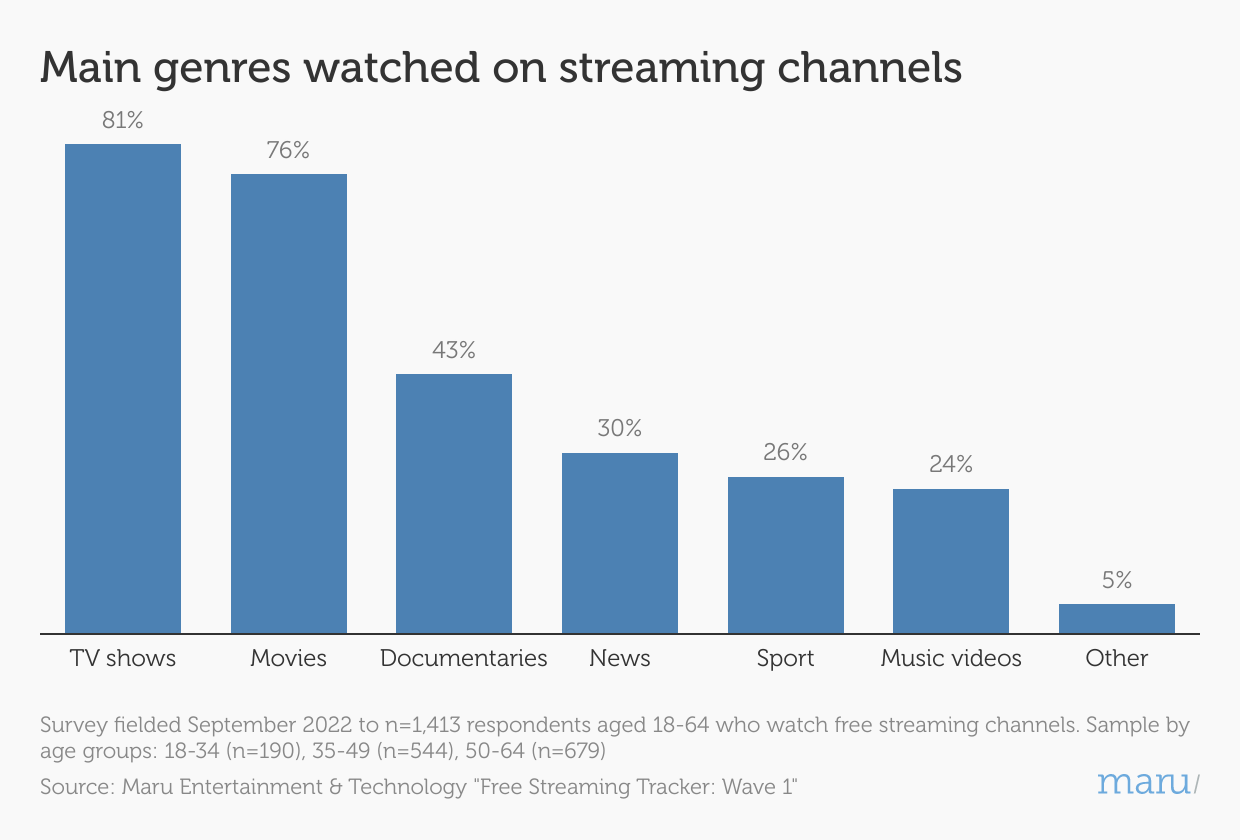Understanding the Free Streaming Channel and FAST Market
By Maru Entertainment & Technology | September 6, 2022
Free streaming channels—in industry parlance, FAST (Free Ad-Supported Streaming TV)—are one of the hottest topics in the entertainment business. International conferences like IBC and MIPCOM are devoting considerable attention to the format, boosted by its success in the United States. They hope that this format can be replicated in international territories.
Yet FAST is a tough topic to measure. There are no service releases of U.S. metrics, and to complicate things further, there is no consumer parlance to refer to what technically are free ad-supported linear streaming channels. The best attempt has been from NBCU’s Peacock, which described its FAST channels as “free streaming channels” in promos airing for Peacock earlier in the year. Additionally, is the fact that there is no FAST-only service, with these typically offering both channels and on-demand content, with Peacock also offering subscriber-only content.
This creates a quandary for market research companies. With the lack of industry measurement, there is a real need for accurate figures to provide context for the growing space. Yet, like VMVPD (virtual Multichannel Video Programming Distributor) services before them, the complexity of the subject means that a simple awareness and usage question will not yield accurate results.
For that reason, Maru’s Entertainment and Technology team has devised an adaptive methodology to best size and understand the state of the U.S. FAST market. First, by laddering respondents from a list of all major services offering free video content, showing detailed descriptions of free streaming channels and on-demand content. Then asking for general free streaming channel viewership, displaying the services with that capability, and then asking for FAST viewership on these channels, a more accurate picture of free streaming channel use emerges.
With FAST services available from Comcast and Charter (Xumo), Paramount Global (Pluto TV), Fox (Tubi), Amazon (Freevee), Roku (Roku Channel), NBCUniversal (Peacock), Dish Network (Sling Free), Vizio (Vizio Watchfree+), LG (LG Channels+), Allen Media Group (Local Now and Sports.TV) and Samsung (Samsung TV Plus) as well as a host of independent options led by Redbox and Plex, it is a very crowded place. The research from Maru Entertainment & Technology found that, with so many services available, the average number being used to watch free streaming channels was 2.1.
With each service offering its own line-up of content and no two services being the same, this is a very plausible finding. It also speaks to a strategy most services utilize regarding their owned and operated channels, for example, MTV Pluto TV or Local Now’s hyperlocal local news channels. These appear on the home service but are also licensed out to competitors. With the average number of services watched being 2, it’s possible to have your content in front of viewers still even if they are not using your service.
Our research found that Peacock is the most popular service used to stream a free streaming channel regularly. With distribution across Comcast, Cox, Charter TV, and internet subscribers, free access to anyone, and a set-up that includes free and paid content under the same roof, it’s easy to see how channels like NBC News Now or the SNL Vault may see regular viewership. The other major FAST services are Roku Channel, Pluto, Tubi, and Freevee, which all see more than 10% of adults (18064) saying they watch free streaming channels on them regularly. (To see how the major services compare on the frequency of viewership, download Maru’s free report on U.S. FAST here).
Our research also found that TV shows and movies are by far the most popular content types currently on FAST. Sports is low as it currently is dominated by niche sports even though several of the major leagues do operate FAST channels (but don’t yet publicize them during broadcasts). News is an area seeing tremendous growth in free streaming, led by hundreds of free streaming channels launching FAST equivalents, so expect to see this area grow. Music videos also see a quarter of adults who watch free streaming say that they watch channels, with this much higher among 18-34s (see our report for a full breakdown), offering opportunities for brands to reach younger consumers.
The type of content available within TV is broad and reflective of cable TV. Genres like true crime, food, travel, and game shows see considerable viewership levels alongside staples like comedy and drama. FAST is also a way for media companies to monetize older content which may not be a subscription streaming draw but command considerable recognition among consumers, which is reflected with classic TV being so high on our genre list.
With each month seeing an increased number of FAST channels launching, it is clearly a space anticipated to continue growing both domestically and internationally. Maru’s Entertainment and Technology team will continue to frequently track the direction of the industry in the U.S. with reports and analysis and is available to consult on any research needs you may have within the free streaming channel space.






